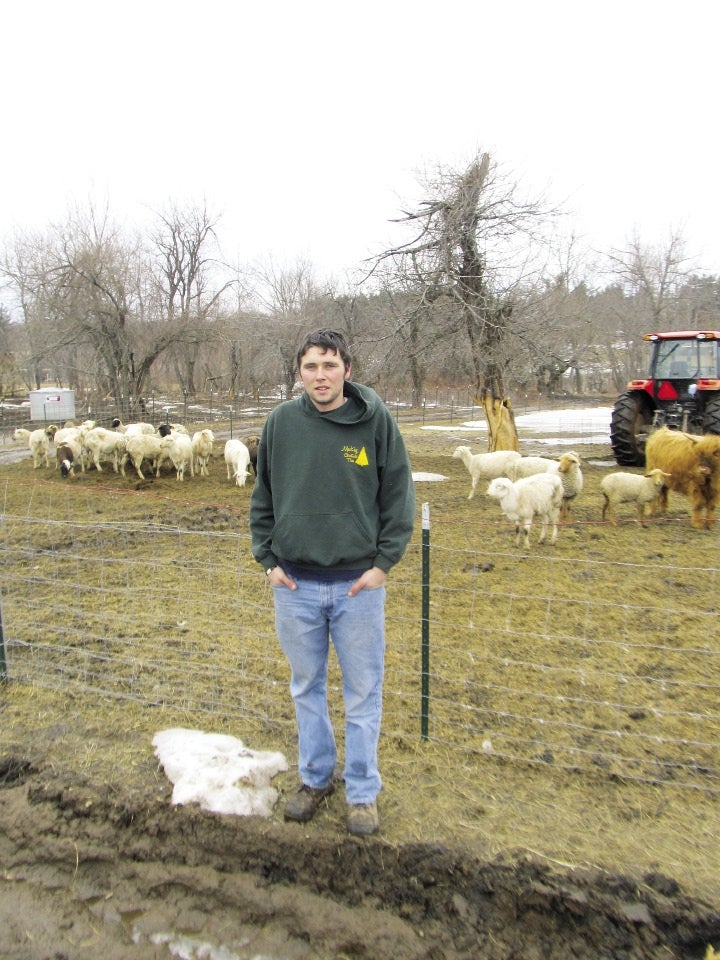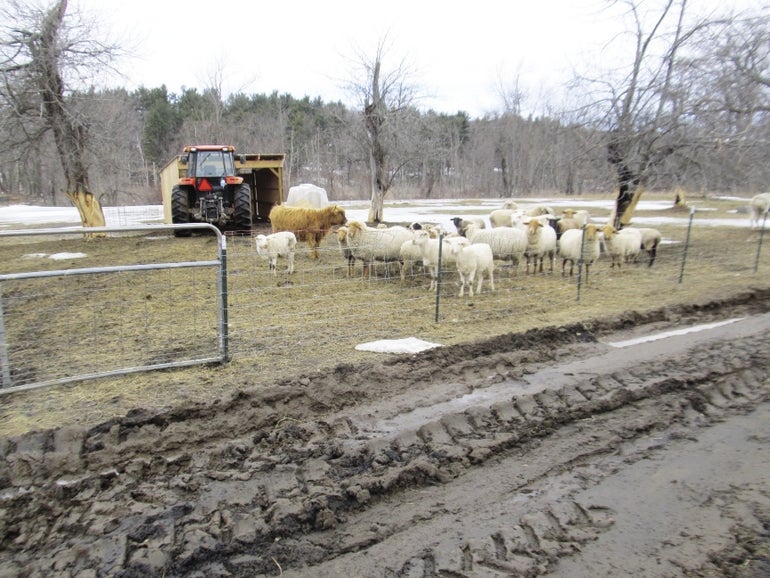An influx of young farmers help seed agriculture's future in Central Mass.
Ryan MacKay always knew he wanted to be a farmer. The grandson of dairy farmers and son of entrepreneurs, MacKay grew up raising goats, sheep and a camel. By the time MacKay turned 14, he was selling Christmas trees.
He worked on different farms throughout high school and attended one of Massachusetts' four agricultural colleges.
At age 20, MacKay started leasing 30 acres to raise livestock. Three years later, his Lilac Hedge Farm consists of 200 acres in two locations in Berlin and West Boylston and is home to cattle, pigs, lamb, chicken and turkeys.
Lilac Hedge employs two part-time workers in the winter and a couple of full- and part-timers in the summer. Now 23, MacKay sells his products through local community-supported agriculture — in which customers pre-pay for weekly shares of the farm's meat — and at least five farmers markets each weekend in Boston.
“It can be a difficult industry, but it's very rewarding,” he said.
A change in consumers' preferences — toward more locally grown food — could be a boost for MacKay and other farmers. Studies have shown that locally grown food improves mental health while reducing childhood obesity and diabetes, according to Rick LeBlanc, who oversees the “MassGrown” program, a division of the state's Department of Agricultural Resources (DAR) that promotes Bay State-grown food.
In many ways, MacKay is the face of a new generation of farming. He's one of 78 Massachusetts farmers under the age of 35 to enter the industry over the past five years, representing a 23 percent jump in that demographic, according to United States Department of Agriculture (USDA) data released last month.
Like MacKay, most of the new farmers have a family history of agriculture, even if their parents didn't work the fields, said Steve Gould, general manager of Hardwick Farmers Co-Op, in Hardwick. And grass-fed beef has been a product of choice for many new farmers, Gould said, since the cattle can graze on hilly pastures with rocks and trees but don't require the corn, hay, grain or equipment of dairy farms.
MacKay has forsaken selling meat to supermarkets or other wholesale vendors and instead retails his product directly to consumers. In fact, farm-to-consumer sales nationwide have more than doubled from $551 million in 1997 to $1.2 billion in 2007, according to the USDA.
In Massachusetts, direct retailing has quadrupled; it represents about 80 percent of agricultural sales today, up from 20 percent in the 1980s, LeBlanc said.
A vehicle of choice for bringing crops or livestock directly to consumers has been farmers markets, which have increased statewide from 80 to 250 over the past 15 years, LeBlanc said. Fifty-five of those markets are in Middlesex County, according to the DAR, with another 42 in Worcester County.
Local food offers superior taste, flavor and nutritional value, said Leigh Youngblood, executive director of the Mount Grace Land Conservation Trust in Athol. Youngblood said local meat and produce can now be found everywhere from high-end restaurants and hospitals to office cafeterias and schools.
A change in state law that allows school districts to purchase 10 percent of their food from local sources — rather than the lowest bidder — has made it possible for students to eat locally-grown food for lunch, LeBlanc said. Fifty one Middlesex County and 44 Worcester County schools work with the state to buy local agricultural products, according to the DAR.
Technology helps marketing
MacKay also considers marketing key to his operation and brings his cell phone into the fields so he can stay connected to email. Previous generations of farmers weren't too concerned about, or good at, marketing, Gould said.
“You used to just grow a whole ton of crops, bring them to Boston and dump them off,” LeBlanc said.
But most farmers start off far smaller than MacKay and don't specialize in livestock.
Livestock sales in the Bay State tumbled by 13 percent from $125 million in 2007 to $109 million in 2012, according to the USDA. Meanwhile, crop sales rose 5 percent, from $364 to $383 million.
The commonwealth doesn't have enough infrastructure to meet the demand for locally-raised meats, according to Richard Bonanno, president of the Massachusetts Farm Bureau. A December fire destroyed Blood Farm in Groton, leaving Adams Farm in Athol as the only place in Massachusetts with a USDA-inspected meat processing facility.
The lack of slaughterhouses has created a real bottleneck during the holiday season, MacKay said, and forced many former Blood Farm customers to go to New York or Vermont to get their livestock killed.
The farm bureau is backing legislation that would aim to reduce the regulatory burden by transferring federal oversight of meat processing facilities to the state. Similar legislation in Maine has doubled the number of slaughterhouses there, according to the farm bureau.
In addition, most of the Bay State's new farms are small. Parcels of less than 50 acres increased 3 percent from 5,084 in 2007 to 5,235 in 2012, according to the USDA.
Intensely farming four-to-six-acre plots has been particularly popular among the younger set, Gould said.
“It's more of a backyard-type movement,” Gould said.
These millennials often see agricultural work as a way to balance out a culture increasingly driven by technical gadgets, Youngblood added.
However, the number of farms statewide between 50 and 999 acres — such as MacKay's — has fallen 4 percent, from 2,579 in 2007 to 2,488 in 2012, according to the USDA.
Large plots are becoming increasingly unsustainable due to the high cost of land. Massachusetts farmland is among the most expensive in the country, with an average price of $11,600 per acre compared to $4,750 in New Hampshire, according to the UMass Agricultural Extension.
These prices make it both tough for newcomers to break into the industry and tempting for landowners to sell to developers.
But government initiatives are working to stem the tide of development.
The commonwealth's land preservation program has permanently protected 15,002 acres of farmland in Worcester County and 2,601 acres in Middlesex County, the DAR found. This program pays property owners the difference between the agricultural and development appraisal rates in exchange for selling off development rights, LeBlanc said.
Some 10,140 acres of farmland in Worcester County and 676 in Middlesex County are temporarily protected through farmland viability grants, according to the DAR. This program gives property improvement grants of between $40,000 and $100,000; in exchange, farmers agree not to sell for a decade, LeBlanc said.
And even when development comes, it can be carried out in a way that preserves the rural landscape, Youngblood said.
Making more space available
Municipalities should modify zoning policies that prohibit the creation of lots smaller than two acres since that can lead to the needless destruction of farmland, said Trish Settles, principal planner of the Central Massachusetts Regional Planning Commission.
Instead, municipal policies should promote dense neighborhood development that maintains as much open space as possible, said Heidi Ricci, senior policy analyst at the Mass Audubon Society. She said young people prefer mixed-use districts with communal open space, which can often include farmland.
This type of cluster development is required in towns such as Bolton and Littleton, according to a report by the Minuteman Advisory Group on Interlocal Coordination.
“There's a great demand for development where people don't have two acres of lawns they have to spend all weekend maintaining,” Ricci said.











0 Comments